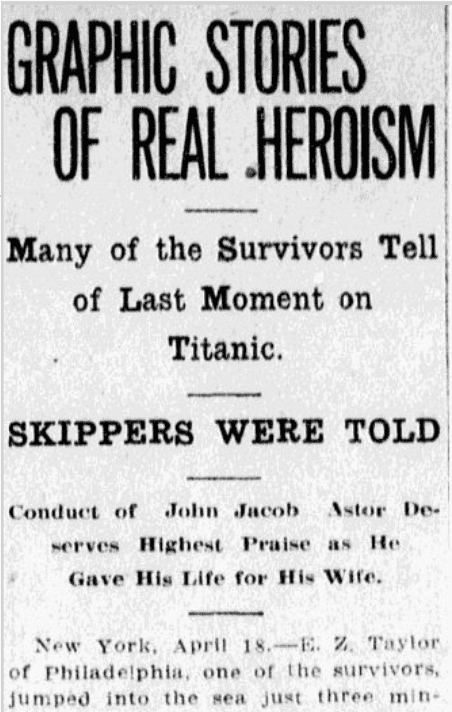Discover True Tales of Tragedy and Heroism
This past April marked the 104th anniversary of the RMS Titanic sinking. Shortly before midnight on 14 April 1912, the ship hit an iceberg and sank at 2:20 a.m. the next day. A lack of enough lifeboats caused the deaths of 1,517 passengers and crew members.
Another passenger ship, the RMS Carpathia, picked up survivors about two hours after the Titanic sank and brought them to New York City, arriving on April 18. The world then began to learn details as harrowing survival stories were published in newspapers.
Here’s a newspaper article with some amazing survival stories from the last moments on the Titanic. This article was published by the Charlotte Observer (Charlotte, North Carolina), on 19 April 1912, page 1:

Graphic Stories of Real Heroism
Survivor E. Z. Taylor, of Philadelphia, jumped into the sea just three minutes before the boat sank. He told a graphic story as he came from the Carpathia.
“There was an awful shock that made the boat tremble from stem to stern. I did not realize for some time what had happened,” Taylor said. “I felt the boat rise and it seemed to me that she was riding over the ice.
“It was a veritable sea of ice and the boat was rocking over it. I jumped into the ocean and was picked up by one of the boats. I never expected to see land again.”
A Colonel Goes Down with the Ship
U.S. Col. Archibald Gracie went down with the ship, and later told how he managed to survive after a wave swept over him before the ship’s final plunge.
“I jumped with the wave,” he said. “By great good fortune I managed to grasp the railing on the deck above and I hung on. When the ship plunged down I was forced to let go and I was swirled around for what seemed to be an interminable time.”
As he surfaced, Col. Gracie and another man in the water saw a life raft floating by and struggled to get toward it.
“We then began the work of rescuing those who had jumped into the sea and were floundering in the water,” he said.
At the break of dawn, Col. Gracie said there were 30 survivors standing knee deep in icy water on the raft, warning others in the water to stay away so as not to collapse their flimsy boat.
“The hours that elapsed before we were picked up by the Carpathia were the longest and most terrible that I ever spent.”
A Man Gives His Life for His Wife
One action that stood out to Col. Gracie was that of millionaire New Yorker Col. John Jacob Astor, who worked to save his young bride, Miss Force of New York, who was in delicate health.
As Miss Force was being lowered into the lifeboat, Col. Astor requested permission to go with her for her own protection.
“No, sir,” replied the second officer, “Not a man shall go on a boat until the women are all off.” Col. Astor then inquired the number of the boat, which was being lowered away, and turned to the work of clearing the other boats, Col. Gracie said.
Col. Astor gave his life to save his bride.
 No Indication of Panic
No Indication of Panic
Despite warnings of icebergs, the commander never gave an order to slow the Titanic, Col. Gracie said. The sea was smooth and the weather clear, so there was seemingly little to fear.
“When Sunday evening came we all noticed the increased cold, which gave plain warning that the ship was in close proximity to icebergs or ice fields,” he said.
“When the vessel struck, the passengers were so little alarmed that they joked over the matter. The few that were on deck early had taken their time to dress properly and there was not the slightest indication of panic.
“Some of the fragments of ice had fallen on the deck and these were picked up and passed around by some of the facetious ones who offered them as mementoes.”
Looking over the port side, Col. Gracie said there was no evidence of damage. However, the ship soon began listing and they were ordered to don life preservers.
One of the last women Col. Gracie saw was Miss Evans, of New York, who refused to be rescued, because, he said, “she had been told by a fortune teller in London that she would meet her death on the water.”
Whether you had ancestors directly involved with the Titanic disaster or simply want to learn more for your own interest, historical newspapers provide stories and details you cannot find anywhere else. GenealogyBank’s Historical Newspaper Archives of more than 15,000 newspapers is full of interesting survival stories, births, deaths, marriages and many other facts about your ancestors!
Explore more than 108,000 newspaper articles about the Titanic online at GenealogyBank today.
